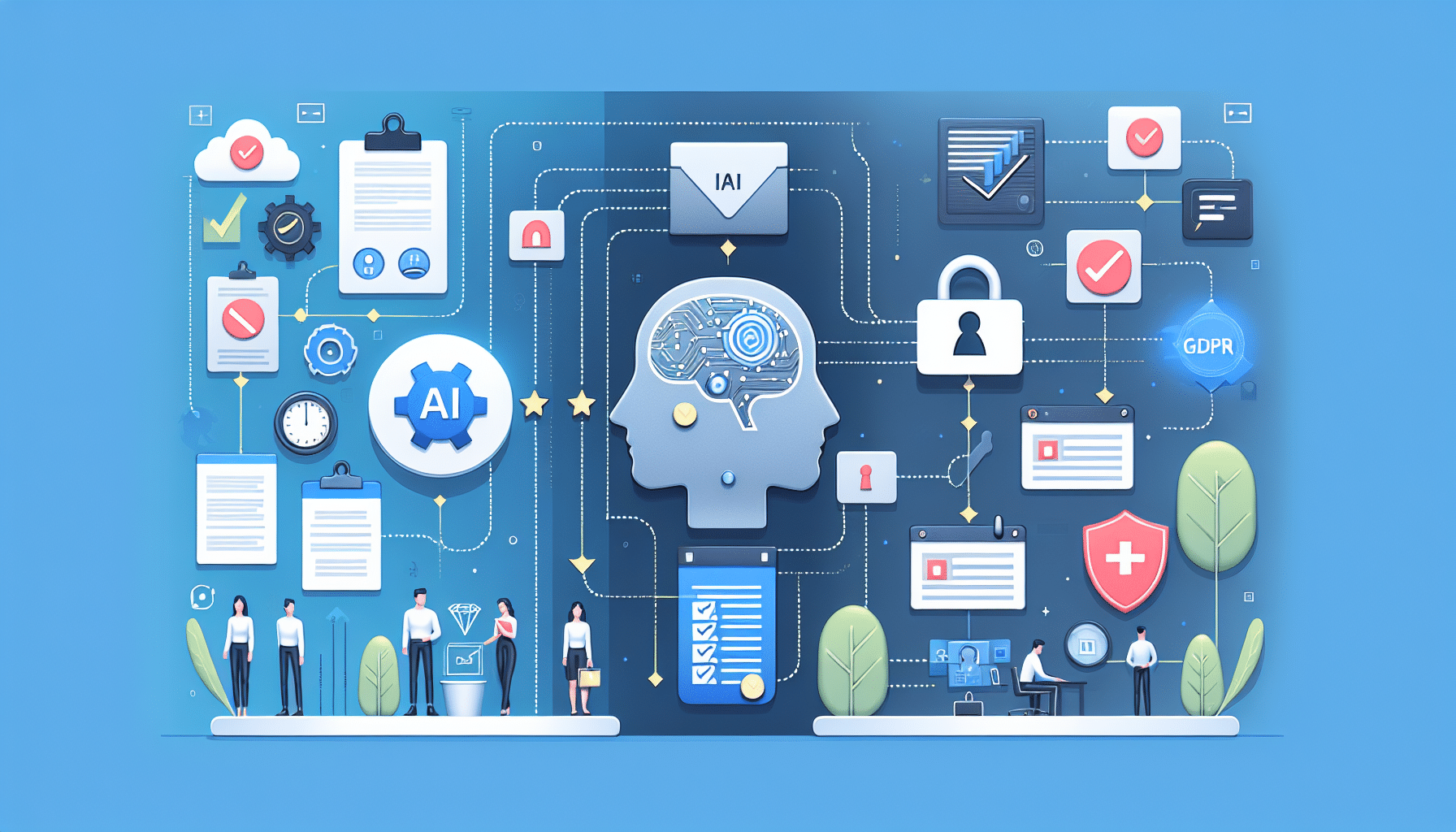About eldris
At Eldris, we automate SEO, multilingual site expansion, and EU compliance for brands scaling across Europe. Our AI-powered platform handles everything from content publishing to regulatory docs—so you don’t have to.
In This Article
- GDPR compliance is essential for data protection and regulatory trust.
- AI solutions offer superior speed, accuracy, and scalability compared to manual processes.
- Automation simplifies DPIAs, SARs, and ongoing risk management.
- Privacy by design is effectively embedded through AI architecture.
- Cost efficiency of AI improves over time through long-term operational savings.
Understanding GDPR Compliance Today
An Overview of the Legal Landscape
The General Data Protection Regulation (GDPR) compliance remains a central concern for any business handling personal data within or transferring data to the European Union. Enforced since May 2018, it aims to give EU citizens greater control over their data, enforce stricter data handling practices, and introduce significant penalties for non-compliance. Organisations must not only process personal data lawfully, but also demonstrate accountability and transparency in every phase of their operations.
This regulatory framework transcends borders, impacting companies globally. With penalties reaching up to €20 million or 4% of annual global turnover, GDPR compliance is not optional—it’s critical. Meeting these requirements demands precise documentation, secure data storage, well-trained staff, and a clear demonstration of lawful data processing practices. Increasingly, businesses are turning to innovative technologies, especially artificial intelligence, to meet these complex obligations.

The Rise of AI-Based GDPR Tools
Automation, Efficiency, and Innovation
Artificial intelligence has revolutionised many operational domains, and data protection is no exception. AI-powered tools for GDPR compliance are designed to automate tasks such as identifying personal data, anticipating risks, and generating necessary reports. These systems can interpret large volumes of data, flag potential breaches, and assist with managing consent—all with remarkable speed and accuracy.
For instance, AI-based data discovery tools help locate sensitive personal information across fragmented platforms. Machine learning algorithms continually evolve to recognise flawed data handling patterns, alerting teams before infractions occur. Natural Language Processing (NLP) enables AI tools to review privacy policies and contracts, ensuring that documentation adheres to the latest regulations.
As organisations increasingly manage multi-channel data flows, these AI solutions offer unmatched scalability. They not only improve initial data mapping but also update compliance statuses in real-time. Compared to manual systems, AI tools provide proactive rather than reactive compliance strategies.
Manual GDPR Compliance: A Legacy Method
Challenges and Operational Costs
Traditional GDPR compliance methods rely on human auditing, manual record-keeping, spreadsheets, and verbal coordination across departments. These manual approaches, while theoretically thorough, are highly resource-intensive and prone to human error. Ensuring ongoing compliance is particularly laborious, especially in organisations with complex data ecosystems.
Staff must routinely audit systems, monitor access logs, and update data inventories. Generating Data Protection Impact Assessments (DPIAs) or managing Subject Access Requests (SARs) through manual tracking can slow response times and increase the risk of non-compliance. Furthermore, organisations may face difficulties keeping up with evolving interpretations of GDPR rulings as new precedents are set.
Time and labour are not the only concerns. The cumulative cost of ongoing training, system updates, and personnel needed for manual GDPR compliance can outweigh the initial investment in smarter technologies. As the digital landscape grows, traditional methods are slowly becoming obsolete.
Comparative Analysis: AI vs Traditional
Metrics: Speed, Accuracy, and Scalability
When comparing AI-driven GDPR compliance to traditional manual methods, three core metrics are key: speed, accuracy, and scalability. AI tools can perform audits across vast datasets in a matter of minutes—tasks that might take humans weeks to accomplish. This acceleration allows teams to focus on strategic initiatives rather than the mechanics of compliance.
Accuracy also markedly improves with AI systems. Automated data tagging and classification reduce the likelihood of miscategorised or missed records. Additionally, AI minimises bias and fatigue, two common issues in manual processes that can compromise data quality. Scalability is perhaps the most significant differentiator. As businesses scale operations or expand to new jurisdictions, AI systems adapt fluidly, incorporating new data flows without the need for substantial reinvestment or retraining.
By contrast, traditional methods often reach a bottleneck in performance and cost as organisational complexity increases. Learn more about GDPR and AI-Powered Compliance Strategies
Data Protection Impact Assessments
How AI Enhances DPIAs
Data Protection Impact Assessments are critical to GDPR compliance, particularly for high-risk data processing activities. AI tools streamline the DPIA process by pre-identifying potential impacts, suggesting risk mitigation strategies, and auto-generating detailed reports. This automation allows data protection officers to complete assessments with far greater speed and consistency.
Many AI DP tools leverage risk modelling frameworks, applying machine learning to identify patterns indicative of data misuse or potential non-compliance. These tools also maintain logs and decision trails, offering a clear record should regulatory authorities require justification.
Such enhancements are invaluable in sectors like healthcare and finance, where processing highly sensitive data is routine. In these contexts, the speed and accuracy of AI can significantly reduce both response times and liability exposure.
Real-Time Monitoring and Alerts with AI
Benefits Over Manual Checking
Real-time monitoring is one of the strongest benefits of AI-based GDPR compliance systems. Unlike periodic manual audits, AI continuously scans for breaches, unauthorised access, and abnormal data flows. This constant vigilance ensures that organisations are immediately alerted when compliance risks arise.
Behavioural analysis tools further enhance this function by learning typical access patterns and signalling deviations. Whether it’s an unexpected export of personal data or a login from an unknown location, AI can flag such events for immediate action. Alerts can be mapped directly to incident response protocols, ensuring no time is wasted in mitigating issues.
Manual systems simply cannot match this level of responsiveness. The lag between data misuse and reaction time in manual setups increases the legal and reputational consequences of a breach. Read a related article
Privacy by Design with AI Systems
Compliance at the Core
The GDPR mandates privacy by design, meaning that data protection must be embedded into every process and system from the outset. AI systems support this principle by integrating privacy-preserving mechanisms into software architecture itself. For example, automated data anonymisation, auto-deletion protocols, and access controls can be activated by default.
Some AI systems employ federated learning models, which train algorithms without transferring raw data—thus reducing data exposure risk. This approach illustrates how smart technology can align with both innovation and regulation. Choosing AI tools that are built with privacy by design at their core ensures moving beyond box-ticking towards genuine data stewardship.
In contrast, retrofitting manual systems for privacy often proves an uphill task, requiring process overhauls and extensive training. AI creates a framework where privacy becomes seamless, fluid, and continuously optimised.
Transparency and Human Oversight
Ensuring Ethical AI Practices
As AI plays a bigger role in GDPR compliance, maintaining transparency and human oversight is critical. AI systems must be explainable; stakeholders should be able to understand how decisions are made, especially when personal data is involved.
Modern AI tools often include explainability modules that illustrate the logic behind risk scores or compliance levels. Incorporating these elements enables regulators, auditors, and data subjects to understand not just what the system did, but why.
Furthermore, the GDPR itself does not absolve humans of responsibility when using automation. Human supervision ensures that complex cases—where context matters—are evaluated ethically. Maintaining a clear audit trail supports accountability and helps resolve disputes swiftly and fairly.
Cost Comparison Over Time
Long-Term ROI of AI Tools
While AI tools for GDPR compliance often require significant upfront investment, the long-term savings are substantial. Manual systems demand continuous monitoring, staffing, training, and consultancy. Over a five-year span, these recurring costs often exceed the one-time expense of integrating an AI-driven platform.
Moreover, AI tools reduce the likelihood of fines and reputational damage by preventing compliance breakdowns before they escalate. By automating regular audits, policy reviews, and training modules, AI frees up resources for strategic priorities. Many companies recoup their investments within 18 to 24 months through improved efficiencies and reduced regulatory risk.
According to independent studies, firms using AI achieve up to 40% lower compliance costs than their manually operating peers. Read about GDPR-compliant AI-based decision-making
Case Studies: Companies Embracing AI
Success Stories and Lessons Learned
Numerous companies have successfully adopted AI-powered GDPR compliance solutions. One example is a leading European telecom provider that implemented a machine learning model to manage data flow transparency across its ecosystem. As a result, Subject Access Request (SAR) turnaround time dropped from five days to 24 hours.
Similarly, a global e-commerce firm deployed an AI-driven data mapping tool to automatically identify customer data stored in legacy systems. This effort helped the company flag outdated records and reduce its data inventory by 28%, minimising compliance risk.
Lesson learned: companies that integrate AI early enjoy a competitive edge in meeting legal standards, customer trust, and operational agility. Success lies not merely in adopting technology but in ensuring alignment with an organisation’s data ethics philosophy.
“AI redefined our GDPR strategy—what once took us months now happens in real time with greater reliability.” – DPO, Multinational Retailer
Final Thoughts: Choosing the Right Path
GDPR compliance is more than a box to tick—it’s a reflection of how a business values trust, transparency, and ethical responsibility. In comparing AI solutions to traditional methods, the evidence points toward a future that is dynamic, responsive, and technologically empowered. AI doesn’t replace human oversight—it enhances it, streamlining operations while maintaining legal and moral integrity.
Ultimately, the decision lies in evaluating current needs, risks, and resources. For many, the scalability, precision, and proactive nature of AI make it an indispensable tool in their compliance toolkit. By investing in AI, organisations position themselves not just for regulatory success but for sustainable innovation well into the future.
Great guide on gdpr-compliance-comparing-ai-solutions-vs-traditional-methods-interactive – Community Feedback
What are the key differences between AI-driven and traditional GDPR compliance methods?
AI-driven methods allow rapid data analysis, automation, and real-time monitoring, while traditional methods often rely on manual processes, which can be slower and more error-prone.
Can AI systems be fully GDPR compliant?
Yes, AI systems can align with GDPR by incorporating privacy by design, regular audits, detailed record-keeping, and ensuring human oversight.
How do organizations ensure AI tools respect GDPR requirements?
Regular Data Protection Impact Assessments, transparent data practices, and robust security protocols help organizations ensure AI tools respect GDPR.








